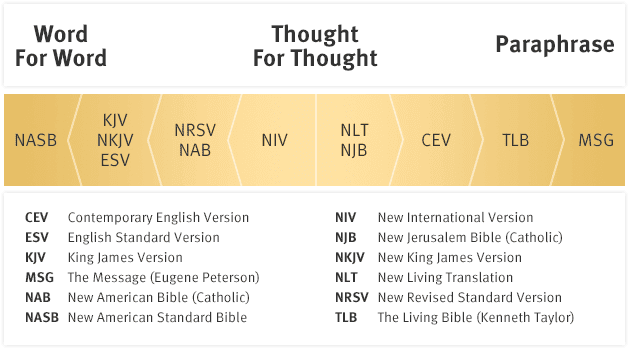

The NIV is also a wonderful translation that seeks to strike that right balance by interpreting slightly less than the NLT and helping with interpretation when necessary where the ESV does not. The ESV is saying it while sticking closer to the actual word usage in the Greek while the NLT is explaining what is meant by each of the words used in the Greek to hopefully make it more understandable in English. NIV (Mediating) – “Through him we received grace and apostleship to call all the Gentiles to the obedience that comes from faith for name’s sake.”Īs you can see, at the root, all three translations are saying the same thing. NLT (Dynamic Equivalence) – “Through Christ, God has given us the privilege and authority as apostles to tell Gentiles everywhere what God has done for them, so that they will believe and obey him, bringing glory to his name.”

This is sometimes referred to as a mediating or optimal translation philosophy.Ī good example the two main philosophies can be seen in Romans 1:5 along with a mediating translation following.ĮSV (Formal Equivalence) – “…through whom we have received grace and apostleship to bring about the obedience of faith for the sake of his name among all the nations…” There also exists a midpoint in the translation philosophy spectrum that works to blend the two options as best as possible. The drawback of this sort of translation philosophy is that it makes interaction with the specific words used a difficult process because the meaning of the thought is being translated, not necessarily the individual words. The benefit of this sort of translation philosophy is that it presents a text that is often easy to read and understand because of the tremendous amount of work that has gone into the rendering of the translated text through a fair bit of helpful interpretation by the translators. The Dynamic Equivalence translation philosophy sees the Formal Equivalence philosophy as a step in the wrong direction and thus attempts to take each thought or meaning the original writer had in mind and translate that thought or meaning into the receptor language. The drawback of this sort of translation philosophy is that the adherence to the specific words used in the original languages sometimes brings to the translation awkward or difficult to understand passages. This option affords the reader of the Bible with the chance to work at the interpretation at a more foundational level. The benefit of this sort of translation philosophy is that it presents a slightly more raw and un-interpreted (as much as possible) translation of the original, which allows the Bible reader and studier to work directly with the specific written words. The Formal Equivalence translation philosophy attempts to take each Hebrew, Aramaic, and Greek word and find the equivalent word in the translation as they take into account the appropriate English grammar standards. Those two endpoints are Formal Equivalence (Word for Word) and Dynamic Equivalence (Thought for Thought). Knowing that, it helps to first begin with a focus on the two ends of the Bible translation philosophy spectrum as Bibles are regularly identified based on their relative closeness to one of the two ends.


Along this spectrum exists a large number of options for a Bible translation to be identified, which can quickly become overwhelming as one first begins to dip one’s toes in this area of study. In studying translation philosophy one quickly discovers there exists a spectrum along which a particular Bible will find itself when the philosophy of a certain translation is discussed. Translation philosophy is the term commonly used within the Bible translation world in order to differentiate the foundation and/or plan for a specific Bible translation. To do this, a discussion of three translation factors will be presented: Translation Philosophy, Translation Accuracy, and Translation Readability. With this short article I would like to highlight three factors of Bible translation I think go a long way towards helping one better grasp why their Bible is the way it is while giving a good foundation for understating why other Bibles are the way they are. Not only does an understanding of different Bible translations help with seeing the differences within translations, but it also begins to deepen one’s respect for those that have given their lives to the work of Bible translation. Through experience we know the New International Version (NIV) does not read like the English Standard Version (ESV) and the New American Standard Bible (NASB) does not read like the King James Version (KJV) and yet they are all the word of God. The study of Bible translations is helpful mainly because it provides a good base for understanding why the Bible you use reads like it does.


 0 kommentar(er)
0 kommentar(er)
